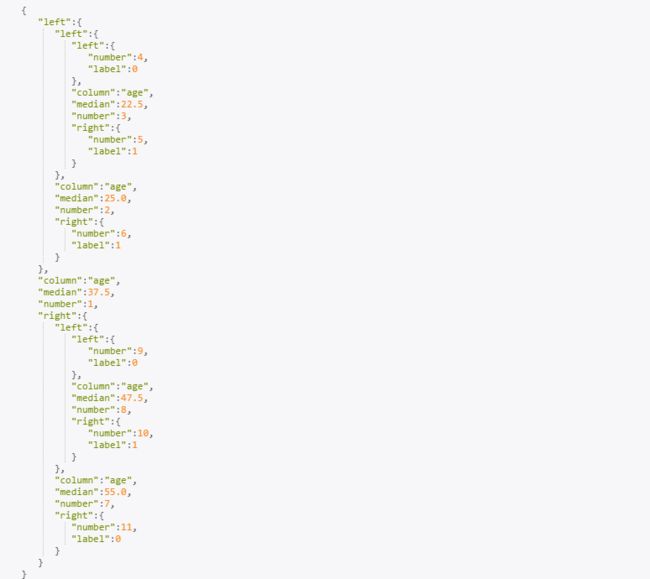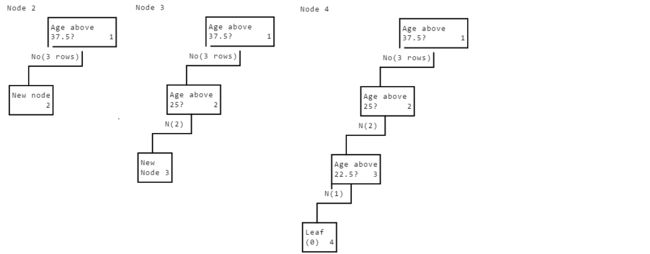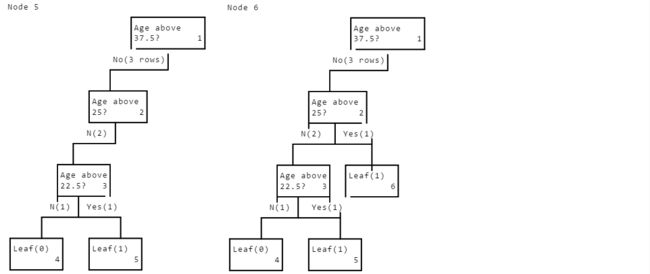个人收入预测——决策树详解
Dataset
决策树的一个优点是它可以处理变量之间有非线性关系的数据,而这种数据用前面的线性回归是不能做的。
- 本文的数据集是美国1994年的个人收入信息,这个数据还包含了婚姻状况,年龄以及工作类型等等。目标是要预测他们每年的收入与50k的关系{<=50:0,>50:1}
import pandas
income = pandas.read_csv("income.csv")
print(income.head(5))
'''
age workclass fnlwgt education education_num \
0 39 State-gov 77516 Bachelors 13
1 50 Self-emp-not-inc 83311 Bachelors 13
2 38 Private 215646 HS-grad 9
3 53 Private 234721 11th 7
4 28 Private 338409 Bachelors 13
marital_status occupation relationship race sex \
0 Never-married Adm-clerical Not-in-family White Male
1 Married-civ-spouse Exec-managerial Husband White Male
2 Divorced Handlers-cleaners Not-in-family White Male
3 Married-civ-spouse Handlers-cleaners Husband Black Male
4 Married-civ-spouse Prof-specialty Wife Black Female
capital_gain capital_loss hours_per_week native_country high_income
0 2174 0 40 United-States <=50K
1 0 0 13 United-States <=50K
2 0 0 40 United-States <=50K
3 0 0 40 United-States <=50K
4 0 0 40 Cuba <=50K
'''Converting Categorical Variables
- 数据集中有很多分类变量:比如workclass(string:State-gov, Self-emp-not-inc, Private),sex(Male,Female)等等。在进行决策树构造之前,我们利用 Categorical.from_array这个函数将分类变量都转换为数值型数据类型。
'''
包括education, marital_status, occupation, relationship, race, sex, native_country, 以及high_income)
'''
# Convert a single column from text categories into numbers.
col = pandas.Categorical.from_array(income["workclass"])
income["workclass"] = col.codes
print(income["workclass"].head(5))
'''
0 7
1 6
2 4
3 4
4 4
Name: workclass, dtype: int8
'''
for name in ["education", "marital_status", "occupation", "relationship", "race", "sex", "native_country", "high_income"]:
col = pandas.Categorical.from_array(income[name])
income[name] = col.codes- Categorical.from_array函数将分类属性Series对象转换为数值型属性分类变量,其分类取值从string变为number.这样在长树过程中,原本是判断一个人workclass是否等于Private来进行分支,现在就是判断一个人的workclass是否等于4(Private这个分类变量被数值型数据4替代了)来进行分支。
Split
- 可以将决策树看成是一个数据流,数据从上往下开始按照一定的规则流入到每个分支,总之最后每个树枝上的数据流总量等于流进树根的数据总量。当树越深,流进每个树枝的流量就越小。我们需要做的是将同一种流量流进同一个叶子,并且该叶子有唯一标签。
Entropy
熵:是用来找到分裂属性的基础。在概率论中,信息熵给了我们一种度量不确定性的方式,是用来衡量随机变量不确定性的,熵就是信息的期望值。若待分类的事物可能划分在N类中,分别是x1,x2,……,xn,每一种取到的概率分别是P1,P2,……,Pn,那么X的熵就定义为:

其中b通常取2,熵值越高,则数据混合的种类越高,其蕴含的含义是一个变量可能的变化越多(反而跟变量具体的取值没有任何关系,只和值的种类多少以及发生概率有关),它携带的信息量就越大。看个例子:

计算一下整体的关于high_income这个属性的信息熵:
import math
# We'll do the same calculation we did above, but in Python.
# Passing 2 as the second parameter to math.log will take a base 2 log.
entropy = -(2/5 * math.log(2/5, 2) + 3/5 * math.log(3/5, 2))
print(entropy)
'''
0.9709505944546686
'''
prob_0 = income[income["high_income"] == 0].shape[0] / income.shape[0]
prob_1 = income[income["high_income"] == 1].shape[0] / income.shape[0]
income_entropy = -(prob_0 * math.log(prob_0, 2) + prob_1 * math.log(prob_1, 2))
'''
income_entropy : 0.7963839552022132
'''Information Gain
由于前面提到熵代表着信息的复杂程度,熵越大,越混乱,而我们要将数据划分为纯净的数据块,因此需要找到熵降低最大的属性来划分数据,这就产生了信息增益,公式如下:
首先计算关于目标变量的信息熵,然后给定一个属性,通过这个属性将数据划分为几块(根据属性的取值个数来决定,当属性个数很大时,选取中位数将其划分为两块),分别计算这几块关于目标变量的信息熵,然后乘以权值(每块所占数据比例)。然后将二者相减,这就得到了信息增益(熵降低的值)。再看个属性取值较多的例子:

import numpy
def calc_entropy(column):
"""
Calculate entropy given a pandas Series, list, or numpy array.
"""
# Compute the counts of each unique value in the column.
counts = numpy.bincount(column)
# Divide by the total column length to get a probability.
probabilities = counts / len(column)
# Initialize the entropy to 0.
entropy = 0
# Loop through the probabilities, and add each one to the total entropy.
for prob in probabilities:
if prob > 0:
entropy += prob * math.log(prob, 2)
return -entropy
income_entropy = calc_entropy(income["high_income"])
median_age = income["age"].median()
left_split = income[income["age"] <= median_age]
right_split = income[income["age"] > median_age]
age_information_gain = income_entropy - ((left_split.shape[0] / income.shape[0]) * calc_entropy(left_split["high_income"]) + ((right_split.shape[0] / income.shape[0]) * calc_entropy(right_split["high_income"])))
'''
age_information_gain : 0.047028661304691965
'''- numpy.bincount(A):传入一个非负整数数组A,然后计算数组中最大的整数值为N,返回一个长度为N+1的数组,分别记录着A中0到N的出现的次数。
Finding The Best Split
- 计算所有属性的信息增益,找到增益最大的那个属性
def calc_information_gain(data, split_name, target_name):
"""
Calculate information gain given a dataset, column to split on, and target.
"""
# Calculate original entropy.
original_entropy = calc_entropy(data[target_name])
# Find the median of the column we're splitting.
column = data[split_name]
median = column.median()
# Make two subsets of the data based on the median.
left_split = data[column <= median]
right_split = data[column > median]
# Loop through the splits, and calculate the subset entropy.
to_subtract = 0
for subset in [left_split, right_split]:
prob = (subset.shape[0] / data.shape[0])
to_subtract += prob * calc_entropy(subset[target_name])
# Return information gain.
return original_entropy - to_subtract
# Verify that our answer is the same as in the last screen.
print(calc_information_gain(income, "age", "high_income"))
'''
0.0470286613047
'''
columns = ["age", "workclass", "education_num", "marital_status", "occupation", "relationship", "race", "sex", "hours_per_week", "native_country"]
information_gains = []
# Loop through and compute information gains.
for col in columns:
information_gain = calc_information_gain(income, col, "high_income")
information_gains.append(information_gain)
# Find the name of the column with the highest gain.
highest_gain_index = information_gains.index(max(information_gains))
highest_gain = columns[highest_gain_index]
'''
highest_gain_index : 3
highest_gain : 'marital_status'
'''ID3 Algorithm
Column Split Selection
- 前面已经写出了计算熵的函数calc_entropy以及计算信息增益的函数calc_information_gain,现在还需要一个函数find_best_column,能返回这个分裂的属性。
columns = ["age", "workclass", "education_num", "marital_status", "occupation", "relationship", "race", "sex", "hours_per_week", "native_country"]
def find_best_column(data, target_name, columns):
information_gains = []
# Loop through and compute information gains.
for col in columns:
information_gain = calc_information_gain(data, col, "high_income")
information_gains.append(information_gain)
# Find the name of the column with the highest gain.
highest_gain_index = information_gains.index(max(information_gains))
highest_gain = columns[highest_gain_index]
return highest_gain
income_split = find_best_column(income, "high_income", columns)Creating A Simple Recursive Algorithm
label_1s = []
label_0s = []
def id3(data, target, columns):
unique_targets = pandas.unique(data[target])
if len(unique_targets) == 1:
if 0 in unique_targets:
label_0s.append(0)
elif 1 in unique_targets:
label_1s.append(1)
return
# Find the best column to split on in our data.
best_column = find_best_column(data, target, columns)
# Find the median of the column.
column_median = data[best_column].median()
# Create the two splits.
left_split = data[data[best_column] <= column_median]
right_split = data[data[best_column] > column_median]
# Loop through the splits and call id3 recursively.
for split in [left_split, right_split]:
# Call id3 recursively to process each branch.
id3(split, target, columns)
# Create the dataset that we used in the example in the last screen.
data = pandas.DataFrame([
[0,20,0],
[0,60,2],
[0,40,1],
[1,25,1],
[1,35,2],
[1,55,1]
])
# Assign column names to the data.
data.columns = ["high_income", "age", "marital_status"]
# Call the function on our data to set the counters properly.
id3(data, "high_income", ["age", "marital_status"])- pandas.unique这个函数返回Series里的独一无二的值,比如Series值是[1,1,2,3,4,4,4],这个函数返回的是[1,2,3,4].当数据集中的target的独一无二的值为1时表示这个数据集都是同一类,因此,是叶子节点。
Storing The Tree
- 采用字典存储树,存储的方式如下,其中number表示这个node的id,发现树是一直向左支扩展,number递增的方向是根左右,前序遍历。
- 对于每个节点,标识其id为number。标记其分裂属性column,标记属性的中值median,其左右分支又是一个node(字典格式,嵌套的字典)。叶子节点还有一个属性label标识其类别。

# Create a dictionary to hold the tree. This has to be outside the function so we can access it later.
tree = {}
# This list will let us number the nodes. It has to be a list so we can access it inside the function.
nodes = []
def id3(data, target, columns, tree):
unique_targets = pandas.unique(data[target])
# 存储树的节点个数
nodes.append(len(nodes) + 1)
# 存储当前node的number:去nodes列表的最后一个元素[1,2...]
tree["number"] = nodes[-1]
if len(unique_targets) == 1:
if 0 in unique_targets:
tree["label"] = 0
elif 1 in unique_targets:
tree["label"] = 1
return
best_column = find_best_column(data, target, columns)
column_median = data[best_column].median()
tree["column"] = best_column
tree["median"] = column_median
left_split = data[data[best_column] <= column_median]
right_split = data[data[best_column] > column_median]
split_dict = [["left", left_split], ["right", right_split]]
for name, split in split_dict:
tree[name] = {}
id3(split, target, columns, tree[name])
id3(data, "high_income", ["age", "marital_status"], tree)A Prettier Tree
- 用字典存储树实在是看不清楚,因此打印出来。当我们遍历到一个node它有label键,表示这是个叶子节点,需要打印它的类别。并且需要记录遍历的深度,这样对于不同深度的节点打印时需要的空格也不同。
- 伪代码如下:

def print_with_depth(string, depth):
# Add space before a string.
prefix = " " * depth
# Print a string, appropriately indented.
print("{0}{1}".format(prefix, string))
def print_node(tree, depth):
# Check for the presence of label in the tree.
if "label" in tree:
# If there's a label, then this is a leaf, so print it and return.
print_with_depth("Leaf: Label {0}".format(tree["label"]), depth)
# This is critical -- without it, you'll get infinite recursion.
return
# Print information about what the node is splitting on.
print_with_depth("{0} > {1}".format(tree["column"], tree["median"]), depth)
for branch in [tree["left"], tree["right"]]:
print_node(branch, depth+1)
print_node(tree, 0)
'''
age > 37.5
age > 25.0
age > 22.5
Leaf: Label 0
Leaf: Label 1
Leaf: Label 1
age > 55.0
age > 47.5
Leaf: Label 0
Leaf: Label 1
Leaf: Label 0
'''Automatic Predictions
def predict(tree, row):
if "label" in tree:
return tree["label"]
column = tree["column"]
median = tree["median"]
if row[column] <= median:
return predict(tree["left"], row)
else:
return predict(tree["right"], row)
print(predict(tree, data.iloc[0]))
'''
0
'''Making Multiple Predictions
new_data = pandas.DataFrame([
[40,0],
[20,2],
[80,1],
[15,1],
[27,2],
[38,1]
])
# Assign column names to the data.
new_data.columns = ["age", "marital_status"]
def batch_predict(tree, df):
return df.apply(lambda x: predict(tree, x), axis=1)
predictions = batch_predict(tree, new_data)
'''
predictions
Series ()
0 0
1 0
2 0
3 0
4 1
5 0
dtype: int64
''' 




